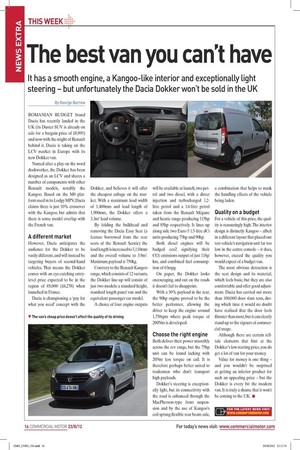The best van you can’t have
Page 9

If you've noticed an error in this article please click here to report it so we can fix it.
It has a smooth engine, a Kangoo-like interior and exceptionally light steering – but unfortunately the Dacia Dokker won’t be sold in the UK
By George Barrow
ROMANIAN BUDGET brand Dacia has recently landed in the UK (its Duster SUV is already on sale for a bargain price of £8,995) and now with the might of Renault behind it, Dacia is taking on the LCV market in Europe with its new Dokker van.
Named after a play on the word dockworker, the Dokker has been designed as an LCV and shares a number of components with other Renault models, notably the Kangoo. Based on the M0 platform used in its Lodgy MPV, Dacia claims there is just 10% crossover with the Kangoo, but admits that there is some model overlap with the French van.
A different market
However, Dacia anticipates the audience for the Dokker to be vastly different, and will instead be targeting buyers of second-hand vehicles. That means the Dokker comes with an eye-catching entrylevel price expected to be in the region of €8,000 (£6,278) when launched in France.
Dacia is championing a ‘pay for what you need’ concept with the Dokker, and believes it will offer the cheapest cubage on the market. With a maximum load width of 1,400mm and load length of 1,900mm, the Dokker offers a 3.3m3 load volume.
By folding the bulkhead and removing the Dacia Easy Seat (a feature borrowed from the rear seats of the Renault Scenic) the load length is increased to 3,110mm and the overall volume to 3.9m3. Maximum payload is 750kg.
Contrary to the Renault Kangoo range, which consists of 12 variants, the Dokker line-up will consist of just two models: a standard height, standard length panel van and the equivalent passenger car model.
A choice of four engine outputs will be available at launch, two petrol and two diesel, with a direct injection and turbocharged 1.2litre petrol and a 1.6-litre petrol taken from the Renault Mégane and Scenic range producing 115hp and 85hp respectively. It lines up along side two Euro-5 1.5-litre dCi units producing 75hp and 90hp.
Both diesel engines will be badged eco2 signifying their CO2 emissions output of just 118g/ km, and combined fuel consumption of 63mpg.
On paper, the Dokker looks encouraging, and out on the roads it doesn’t fail to disappoint.
With a 50% payload in the rear, the 90hp engine proved to be the better performer, allowing the driver to keep the engine around 1,750rpm where peak torque of 200Nm is developed.
Choose the right engine
Both deliver their power smoothly across the rev range, but the 75hp unit can be found lacking with 20Nm less torque on call. It is therefore perhaps better suited to tradesmen who don’t transport high payloads.
Dokker’s steering is exceptionally light, but its connectivity with the road is enhanced through the MacPherson-type front suspension and by the use of Kangoo’s coil sprung flexible rear beam axle, a combination that helps to mask the handling effects of the vehicle being laden.
Quality on a budget
For a vehicle of this price, the quality is reassuringly high. The interior design is distinctly Kangoo – albeit in a different layout that placed our test vehicle’s navigation unit far too low in the centre console – it does, however, exceed the quality you would expect of a budget van.
The most obvious detraction is the seat design and its material, which feels basic, but they are also comfortable and offer good adjustment. Dacia has carried out more than 100,000 door slam tests, during which time it would no doubt have realised that the door feels flimsier than most, but it can clearly stand up to the rigours of commercial usage.
Although there are certain telltale elements that hint at the Dokker’s low starting price, you do get a lot of van for your money.
Value for money is one thing – and you wouldn’t be surprised at getting an inferior product for such an appealing price – but the Dokker is every bit the modern van. It is truly a shame that it won’t be coming to the UK. ■








































